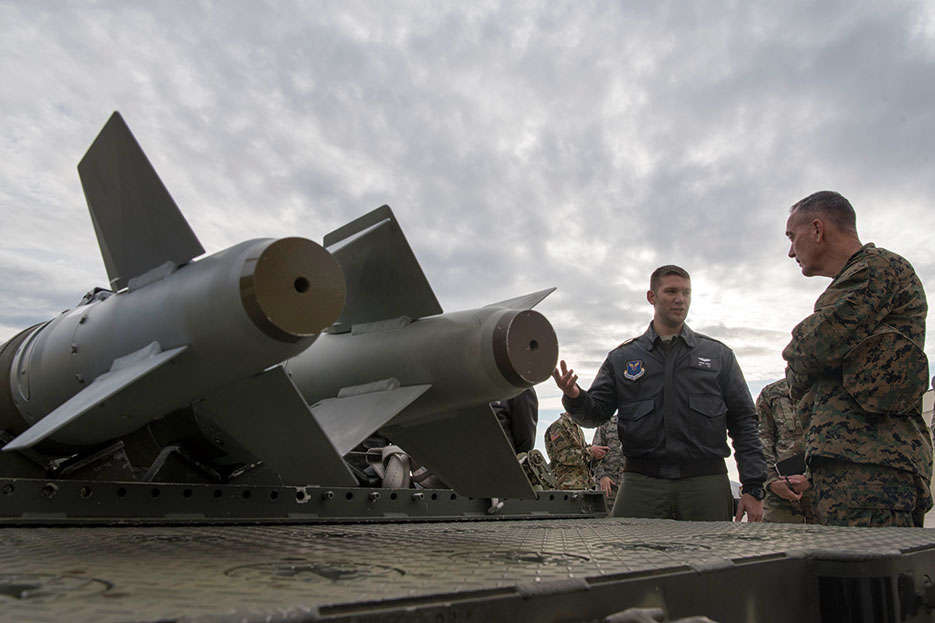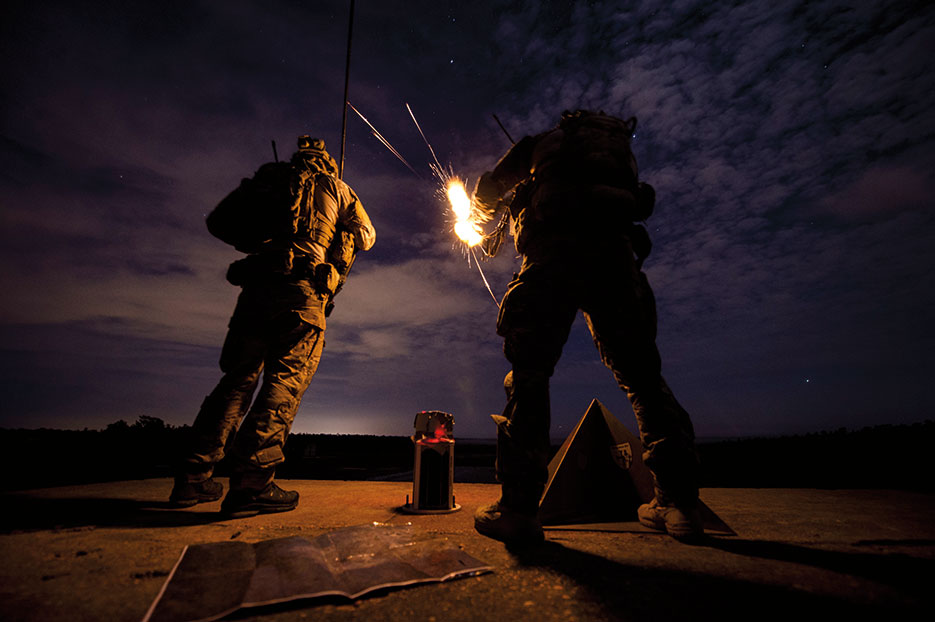
General Dunford and Senior Enlisted Advisor to the Chairman, Sergeant Major John W. Troxell, meet with crew of Boeing B-52H to observe Air Force Nuclear Triad operations and talk to Airmen, Minot Air Force Base, North Dakota, November 2, 2016, (DOD/Dominique A. Pineiro)
Any coach will tell you that the first step in training a fighter is developing a “boxer’s stance,” the foundational posture from which all offensive and defensive movements flow. A good boxer’s stance conserves energy while keeping the fighter balanced, protected, and ready to throw quick, powerful punches. Between fights or between rounds, any assessment of a fighter’s performance must begin with the stance.
While the Joint Force remains the most capable military in the world today, adversary investments, a decade and a half of continuous combat operations, and years of budgetary instability have eroded our competitive advantage and reduced our ability to project power where and when needed. As a nation that thinks and acts globally, the United States does not have the luxury of choosing between a force that can fight nonstate actors, such as the Islamic State of Iraq and Syria (ISIS) and al Qaeda, and one that can deter and defeat adversaries possessing a full array of military capabilities. We also cannot afford to choose between meeting today’s operational requirements and making the investments necessary for tomorrow. Because we do not know when, where, or under what conditions the next fight will occur, the U.S. military must maintain a boxer’s stance—with the strength, agility, and resilience required to fight and win against any potential adversary. Maintaining this stance requires us to develop and advance the capabilities, posture, operating concepts, and human capital necessary to assure our allies and partners, deter adversaries, compete on a day-to-day basis, and, when necessary, respond across the spectrum of conflict.
The first element of an effective boxer’s stance requires us to develop and maintain a balanced inventory of joint capabilities and capacities. As a result of sustained high operational tempo and an unpredictable fiscal environment over the last several years, we now face readiness shortfalls and a bow wave of modernization requirements across the Services. This challenge is particularly acute within the nuclear enterprise, which is why we are actively recapitalizing platforms in each leg of the nuclear triad to ensure that our deterrent remains safe, secure, reliable, and effective. Continued investments in space and cyberspace capabilities allow us to deny adversary objectives, impose costs on those who conduct attacks, and ensure resiliency across all domains. We are also investing in power projection capabilities that allow us to deliver the right force at the right time. These capabilities are essential to overcoming an increasingly lethal array of integrated air defense systems, ballistic and cruise missiles, unmanned aerial and subsurface vehicles, and advanced aircraft, all of which are enabled by adversary electronic warfare capabilities. Other shortfalls and modernization requirements can be found across the Joint Force and getting the right balance of capabilities remains one of our most pressing non-operational challenges.
Second, an agile and resilient stance requires us to prioritize and allocate resources geographically to effectively manage the risks posed by our five priority strategic challenges: Russia, China, Iran, North Korea, and violent extremism, which includes organizations such as ISIS and al Qaeda. Setting the globe correctly not only balances risk, but it also assures our allies and partners, optimizes our ability to respond to crisis, and improves our resilience across domains and warfighting functions.

Airmen assigned to 22nd Special Tactics Squadron participate in U.S. Special Operations Command Exercise Emerald Warrior 17, during which joint special operations forces train to respond to various threats across spectrum of conflict, Eglin Range, Florida, March 4, 2017 (U.S. Air Force/Nicholas Dutton)
The third element underpinning our boxer’s stance is the family of joint concepts that propose new approaches to address compelling operational challenges. Informed by national strategy, joint concepts articulate a vision for deploying, employing, and sustaining the force in the years ahead—in short, they guide how we will fight on tomorrow’s battlefields. By offering educated judgments about future military challenges, joint concepts play a significant role in defining future requirements and addressing gaps in our existing approaches and capabilities. As such, they guide our priorities for capability development and innovation.
Two interdependent activities, exercises and experimentation, help to bring joint concepts to life. Throughout history, military exercises have served to reduce uncertainty, increase readiness, and refine and test new concepts. Recognizing the complexity of today’s strategic landscape, we are reenergizing and reorienting the joint exercise program to develop a shared understanding about the array of threats we face, collectively assess our preparedness to respond to contingencies, and uncover vulnerabilities in our operational plans and concepts. We are complementing and reinforcing this effort through joint experimentation. Experimentation done in concert with exercises, wargames, or simulations can yield significant military capabilities, as demonstrated by the U.S. Navy’s experimentation with aircraft carriers in the 1920s and U.S. Army air-mobile exercises leading up to Vietnam. This kind of innovation—in both our concepts and our material capabilities—is what will allow us to identify and leverage fundamentally new ways to counter tomorrow’s threats.
Finally, we understand that human capital is the ultimate hedge against future uncertainty and that the men and women of the Joint Force are the foundation upon which our boxer’s stance is built. While war will always be chaotic and violent, its character is changing rapidly. Consequently, we must invest in adaptive, innovative, and critically thinking leaders who can thrive at the speed of war in the 21st century; it is no longer enough for leaders to simply be experts in a particular functional area. Given the complexities of today’s fights, leaders must also be wise enough to recognize when short-term tactical and operational gains may be at odds with long-term strategic imperatives. Accordingly, we are refocusing on how to best select, train, and educate the Servicemembers who will lead tomorrow’s Joint Force.
By the time this article goes to print, many of you will have seen the Service chiefs, combatant commanders, and me offer our annual testimony before Congress. While senior leaders help guide the force, it is up to every Soldier, Marine, Sailor, Airman, and Coastguardsman to think through the challenges of tomorrow. The Joint Force’s true competitive advantage comes from the quality of men and women we have in the force today. Maintaining our advantage and ensuring that we never send Americans into a fair fight is our shared obligation. Consequently, your ideas matter, and I am counting on you to contribute to this dialogue. JFQ
General Joseph F. Dunford, Jr.
Chairman of the Joint Chiefs of Staff